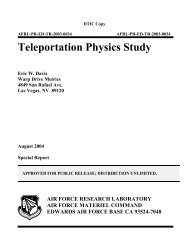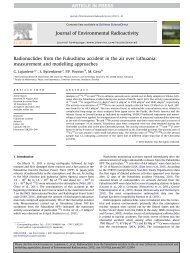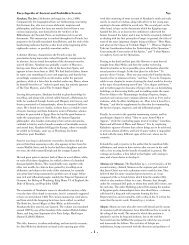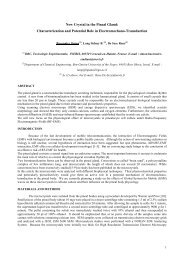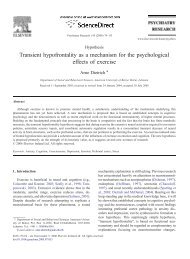Psychology of Terrorism - National Criminal Justice Reference Service
Psychology of Terrorism - National Criminal Justice Reference Service
Psychology of Terrorism - National Criminal Justice Reference Service
You also want an ePaper? Increase the reach of your titles
YUMPU automatically turns print PDFs into web optimized ePapers that Google loves.
effects that help facilitate violence. First, aggression becomes more justifiable when aimed against“bad”people, particularly those who intentionally cause harm to others. Second, extremists describe theresponsible party as “evil”; dehumanizing a target in this regard further facilitates aggression. Third,those suffering adverse conditions at the hands <strong>of</strong> others do not see themselves as “bad” or “evil”;this furtheridentifies the responsible person or group as different from those affected and, thus, makes justifyingaggression even easier.- Also, it is important to understand that analyzing counterterrorist intelligence requires anunderstanding <strong>of</strong> behavior, not just ideology. Investigators and analysts who attempt to understandand anticipate how a person will act in a given situation should seek to understand that individual’s“map,” or perception, <strong>of</strong> the situation. Ideology may be a part <strong>of</strong> that, but other important dynamicsand behavioral factors may contribute as well.24. Bourne, L. E., Healy, A. F., & Beer, F. A. (2003). Military conflict and terrorism: General psychologyinforms international relations. Review <strong>of</strong> General <strong>Psychology</strong>, 7(2), 189-202.Call Number: Editor's Annotation: Empirical study <strong>of</strong> college student’s hypothetical responses toaggression from another nation state. Examined personality styles in addition to experimentalcondition-Persons higher in dominance almost always advocated for more aggressive retaliation than thosewho were more submissive. A similar but less robust or reliable trend was found for greateraggression in more conservative students than those that were more liberal-Anticipated reactions were similar for military and terrorist attacks.-Men and women showed similar levels <strong>of</strong> conflict in their reactions, unless a peace treaty was inplace, in which women were more forgiving and men more aggressive.-Responses escalated in level <strong>of</strong> conflict after repeated attacks.-Very little discussion <strong>of</strong> methods.-Very little generalizability, given college student sample.-Does not contribute to understanding terrorist behaviour.-Strength <strong>of</strong> personality variables in predictory response is interesting.25. Bowyer-Bell, J. (1998). The dynamics <strong>of</strong> the armed struggle. London: Frank Cass and Co.Call Number: Editor's Annotation: The Dynamics <strong>of</strong> the Armed Struggle is an authoritative andprovocative analysis <strong>of</strong> the nature <strong>of</strong> one <strong>of</strong> the time's most prevalent forms <strong>of</strong> political violence.-Dr Bowyer Bell has attended wars, not seminars, in pursuit <strong>of</strong> data, insight and explanation, and hasbeen shot at, kidnapped, expelled and questioned from Central America to Northern Ireland: ascholar amid terror. The text arises from his access to the underground, from time spent in therevolutionary ecosystem and among those who kill to make a dream real. The result is a uniqueanalysis that transcends traditional studies <strong>of</strong> insurgency or terrorism, depicting a strange worldwhere the will is trusted, not tangible assets, where a galaxy <strong>of</strong> the faithful seeks to alter history.Sometimes the will prevails over the assets <strong>of</strong> the state: the weak win because their will endures untilthe centre fails.-The structure that the faithful create, everywhere different yet everywhere the same, has not beenexamined before from the inside out. The Dynamics <strong>of</strong> the Armed Struggle is both a special and ageneral study <strong>of</strong> the hidden world <strong>of</strong> the gunman not as a mirror image <strong>of</strong> everyday reality amenableto academic tools, but as perceived by a scholar with a visa into violence. The reader will no longerfind the armed struggles <strong>of</strong> our time inexplicable, merely horrible, yet emerging as cohesive meansto act on events. This book <strong>of</strong>fers a compelling insight into an elusive phenomenon, a process that attimes allows the few to change the course <strong>of</strong> history.26. Brackett, D. W. (1996). Holy terror: Armageddon in Tokyo. New York: Weatherhill.Call Number: Editor's Annotation: This book provides a fairly detailed account <strong>of</strong> the evolution <strong>of</strong>the Aum Shinri Kyo from Buddhist sect to cult and ultimately to apocalyptic terrorist group. Itcovers the plan and execution <strong>of</strong> the now famous Sarin nerve gas attack on the Tokyo subway, butalso details other atrocities committed by Aum members both within the group (e.g., purification



